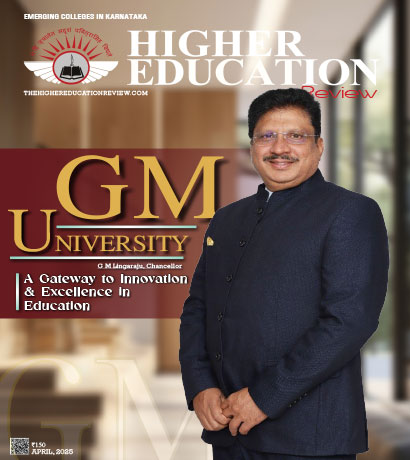Digital Learning Transforms The Spread Of Higher Education

Prof. R P Dubey, Vice Chancellor Dr. C V Raman University, Bilaspur, Chhattisgarh
Michael G. Dolence and Donald M. Norris in their book titled "Transforming Higher Education, A Vision for Learning in the 21st century" highlighted how the society is undergoing a fundamental transformation where it is realigning itself from the Industrial Age to the Information Age. The statement holds relevance more than ever before. The world is in the midst of a digital revolution where technology is taking over nearly all domains of life.
The sphere of higher education has been greatly influenced by digitalization. From traditional classroom setups, we are moving towards more interactive digital modules,
Massive Open Online Courses (MOOCs), and various other online forums. The traditional definition of a classroom is being redefined. The online presence of universities and learning spaces globally as well as in India is constantly growing. According to KPMG, the Indian online education industry will touch $1.96 billion by 2021. Along with this, the Union Budget 2020-21 has seen a 23 percent increase in the allocation of funds to the Digital India campaign, which further lays emphasis on how digitalization is becoming an essential segment of strengthening the economy.
As an attempt to ensure access to education for everyone, including the economically disadvantaged students, the Centre has allocated degree-level full-fledged online
education programs that will be offered by institutes ranked in the top 100 by the National Institutional Ranking Framework. In addition to this, more internship opportunities and diploma courses will also be introduced by the year 2021.
Technology then is transforming the spread of higher education in more ways than one. Some of the features that enable this transformation are as follows:
1. Breaks Down Geographical Barriers: The greatest benefit that technology has delivered would be that it has broken down the barriers of space and time and
has brought the world closer. Through the medium of online platforms, students irrespective of their geographical location can access learning materials. The availability of online education has made it possible for many people residing in remote locations to access these resources.
2. Wider Range of Options: With the elimination of geographical bounds, students can access a wide range of courses and then choose to pursue the one that aligns best with their personal interests. Pursuing a course of interest ensures a promising career for the student and also contributes significantly towards increased job satisfaction in the long run. With the availability of these innovative courses, a lot of Indian students who are already enrolled in traditional undergraduate or postgraduate degree courses are also looking at MOOCs as modes of additional qualification. It has been reported that 40 percent of the students pursuing MOOCs in India are enrolled in traditional university setups alongside.
3. Access to an International Curriculum: The advent of technology has made accessing world-class education easier than ever before. Students from developing nations can now pursue an education guided by global standards. The increased access to more global education has attracted even the highly educated Indian students who are also enrolling in the courses to improve their skill set. About 84.3 percent of the students who already hold degrees have post-secondary degrees and nearly 40 percent have graduate degrees.
4. Greater Flexibility: The option of acquiring a formal degree on an online platform with a greater amount of flexibility has enabled a lot of people to pursue higher education. People who are tied down due to different reasons and cannot afford to go to school full time can now get a chance to improve their skill set, get a degree and eventually find better livelihood opportunities, thanks to the internet.
5. Inclusive for Everyone: The traditional curriculum may or may not be best suited for people with special needs. Online education, however, can be structured in a manner where it could cater to the needs of people dealing with visual impairment, hearing impairment, problems with language and comprehension and even learning disabilities. Online learning platforms prove to be a great boon for people who might find it rather difficult to keep up in a traditional classroom setup.
"The sphere of higher education has been greatly influenced by digitalization, from traditional classroom setups, we are moving towards more interactive digital modules."
6. Interactive Curriculum: The use of interactive curriculum incorporated in online education has gone great lengths in adding value to education. It has systematically improved retention by making the process interesting that has, in turn, persuaded a lot of prospective students into opting for these courses. Psychological findings have revealed that the human brain processes images and videos 60,000 times faster than text. When students engage with the concepts rather than being involved in passive absorption, the courses benefit them in the long run.
Digital Learning then has opened up a world of possibilities. It has transformed not just how higher education is pursued but also how it is perceived. There remains immense potential in the industry and with the upcoming advancements; we can expect to be acquainted with an array of new opportunities in the future.
Prof. R P Dubey, Vice Chancellor
Prof. R.P. Dubey is the Vice-Chancellor of Dr.C.V. Raman University, Bilaspur. He is a senior academician with administrative and governance experience. The exposure and contributions to various functions "from teaching at one end of the spectrum to managing institutions at the other" defines his career.
The sphere of higher education has been greatly influenced by digitalization. From traditional classroom setups, we are moving towards more interactive digital modules,
Massive Open Online Courses (MOOCs), and various other online forums. The traditional definition of a classroom is being redefined. The online presence of universities and learning spaces globally as well as in India is constantly growing. According to KPMG, the Indian online education industry will touch $1.96 billion by 2021. Along with this, the Union Budget 2020-21 has seen a 23 percent increase in the allocation of funds to the Digital India campaign, which further lays emphasis on how digitalization is becoming an essential segment of strengthening the economy.
As an attempt to ensure access to education for everyone, including the economically disadvantaged students, the Centre has allocated degree-level full-fledged online
education programs that will be offered by institutes ranked in the top 100 by the National Institutional Ranking Framework. In addition to this, more internship opportunities and diploma courses will also be introduced by the year 2021.
Technology then is transforming the spread of higher education in more ways than one. Some of the features that enable this transformation are as follows:
1. Breaks Down Geographical Barriers: The greatest benefit that technology has delivered would be that it has broken down the barriers of space and time and
has brought the world closer. Through the medium of online platforms, students irrespective of their geographical location can access learning materials. The availability of online education has made it possible for many people residing in remote locations to access these resources.
2. Wider Range of Options: With the elimination of geographical bounds, students can access a wide range of courses and then choose to pursue the one that aligns best with their personal interests. Pursuing a course of interest ensures a promising career for the student and also contributes significantly towards increased job satisfaction in the long run. With the availability of these innovative courses, a lot of Indian students who are already enrolled in traditional undergraduate or postgraduate degree courses are also looking at MOOCs as modes of additional qualification. It has been reported that 40 percent of the students pursuing MOOCs in India are enrolled in traditional university setups alongside.
3. Access to an International Curriculum: The advent of technology has made accessing world-class education easier than ever before. Students from developing nations can now pursue an education guided by global standards. The increased access to more global education has attracted even the highly educated Indian students who are also enrolling in the courses to improve their skill set. About 84.3 percent of the students who already hold degrees have post-secondary degrees and nearly 40 percent have graduate degrees.
4. Greater Flexibility: The option of acquiring a formal degree on an online platform with a greater amount of flexibility has enabled a lot of people to pursue higher education. People who are tied down due to different reasons and cannot afford to go to school full time can now get a chance to improve their skill set, get a degree and eventually find better livelihood opportunities, thanks to the internet.
5. Inclusive for Everyone: The traditional curriculum may or may not be best suited for people with special needs. Online education, however, can be structured in a manner where it could cater to the needs of people dealing with visual impairment, hearing impairment, problems with language and comprehension and even learning disabilities. Online learning platforms prove to be a great boon for people who might find it rather difficult to keep up in a traditional classroom setup.
"The sphere of higher education has been greatly influenced by digitalization, from traditional classroom setups, we are moving towards more interactive digital modules."
6. Interactive Curriculum: The use of interactive curriculum incorporated in online education has gone great lengths in adding value to education. It has systematically improved retention by making the process interesting that has, in turn, persuaded a lot of prospective students into opting for these courses. Psychological findings have revealed that the human brain processes images and videos 60,000 times faster than text. When students engage with the concepts rather than being involved in passive absorption, the courses benefit them in the long run.
Digital Learning then has opened up a world of possibilities. It has transformed not just how higher education is pursued but also how it is perceived. There remains immense potential in the industry and with the upcoming advancements; we can expect to be acquainted with an array of new opportunities in the future.
Prof. R P Dubey, Vice Chancellor
Prof. R.P. Dubey is the Vice-Chancellor of Dr.C.V. Raman University, Bilaspur. He is a senior academician with administrative and governance experience. The exposure and contributions to various functions "from teaching at one end of the spectrum to managing institutions at the other" defines his career.

